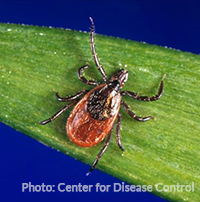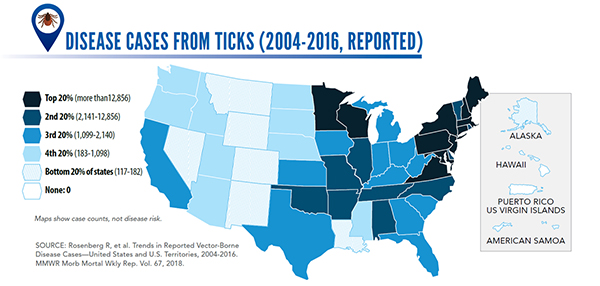The beauty and benefits of being outdoors always seems to have a fallback. In this case, it is ticks within the Adirondacks. The Adirondacks is a beautiful place where many people venture into the woods to explore the nature. However, as visitors return home, they often find the 8-legged tick critters attached to their body. In essence, the Adirondack region is seeing an increase in the number of tick-borne illnesses. In previous years, the number of ticks and tick-borne illness were low within the Adirondacks. However, climate change and the rising temperature of the earth has caused the tick populations to increase. The increase in tick borne illnesses within the Adirondacks is a complex and evolving issue.

First, it is important to understand how ticks’ function. There is a wide variety of ticks, however the ticks that are most important to be cautious of are black legged ticks (also known as deer ticks). This is because deer ticks can transmit a bacterium that can cause Lyme disease and many other tick-borne illnesses.

https://www.cdc.gov/ticks/life_cycle_and_hosts.html
As we can notice, an increase in tick population can be very harmful to humans. In the Adirondacks, there has been an increase in the tick populations. This is due to the warming temperatures and climate change. As the temperatures rise, ticks within the Adirondacks can withstand the climate more easily allowing them to be able to reproduce and grow their population. To begin, New York State is already known for having a high tick population. For example, New York State is in the top 20% of number of cases of tick-borne illnesses (Adirondack Council 2018). Over the past 20 years, the number of cases of Lyme disease has increased 1.5-fold statewide. But, more specifically counties within the Adirondacks have had a twentyfold jump in the past twenty years (Adirondack Council 2018). It is apparent that there is a large increase in the number of tick-borne illnesses within the Adirondacks. For example, in 2009 New York State (excluding NYC) saw roughly 300 cases of anaplasmosis (illness associated with ticks), but in 2018 the number of cases anaplasmosis had nearly tripled. More specifically, roughly 20% of the ticks containing anaplasmosis were found in Warren County, which is within the Adirondack region, while in 2009 there were no ticks containing this bacterium found in Warren County (Adirondack Explorer 2020). Not only is the amount of deer ticks carrying Lyme disease increasing within the Adirondacks, but researchers have also now found other rare tick-borne illnesses within the Adirondacks. For example, there has been evidence of ticks carrying babesiosis (disease like malaria) to be found within this region. Research has shown that the Adirondacks has higher rates of tick-borne illness exposure compared to other areas of NY (Adirondack Daily Enterprise 2018). It is unclear as to why the Adirondacks may have higher exposure to the tick-borne illness, but some researchers suspect that the ticks within the Adirondacks are better at spreading the disease (Adirondack Daily Enterprise 2018).

Now, the big question may be how we fix this issue. Unfortunately, it does not appear that there is an easy fix. It is predicted that as the climate change continues, there will be an increase in the number of ticks. Therefore, one of the only ways to prevent these tick-borne illnesses is to protect yourself and be cautious of ticks. Individuals who are hiking in the Adirondacks should take precautionary measures and always do tick checks when they exit wooded areas. It is essential that everyone is aware of ticks when venturing out into the Adirondack woods!
Works Cited:
Council, Adirondack. “Don’t Get ‘Ticked’: Everything You Need to Know.” Adirondack Council, www.adirondackcouncil.org/page/blog-139/news/dont-get-ticked–everything-you-need-to-know-1091.html.
“How Ticks Spread Disease.” Centers for Disease Control and Prevention, Centers for Disease Control and Prevention, 21 Sept. 2020, www.cdc.gov/ticks/life_cycle_and_hosts.html.
Says, Allan, et al. “Tick Disease with Covid-19 Symptoms on the Rise in Northeastern New York.” Adirondack Explorer, 7 Jan. 2021, www.adirondackexplorer.org/stories/tick-disease-on-the-rise.
“Ticks in the Adirondacks.” Ticks in the Adirondacks | News, Sports, Jobs – Adirondack Daily Enterprise, www.adirondackdailyenterprise.com/news/local-news/2018/08/ticks-in-the-adirondacks/.
“Ticks: They’re Baaaaaaack -.” The Adirondack Almanack, 2 Apr. 2021, www.adirondackalmanack.com/2021/04/ticks-theyre-baaaaaaack.html.
For this blog post, I met and discussed the blog with our class writing tutor Nhan.
